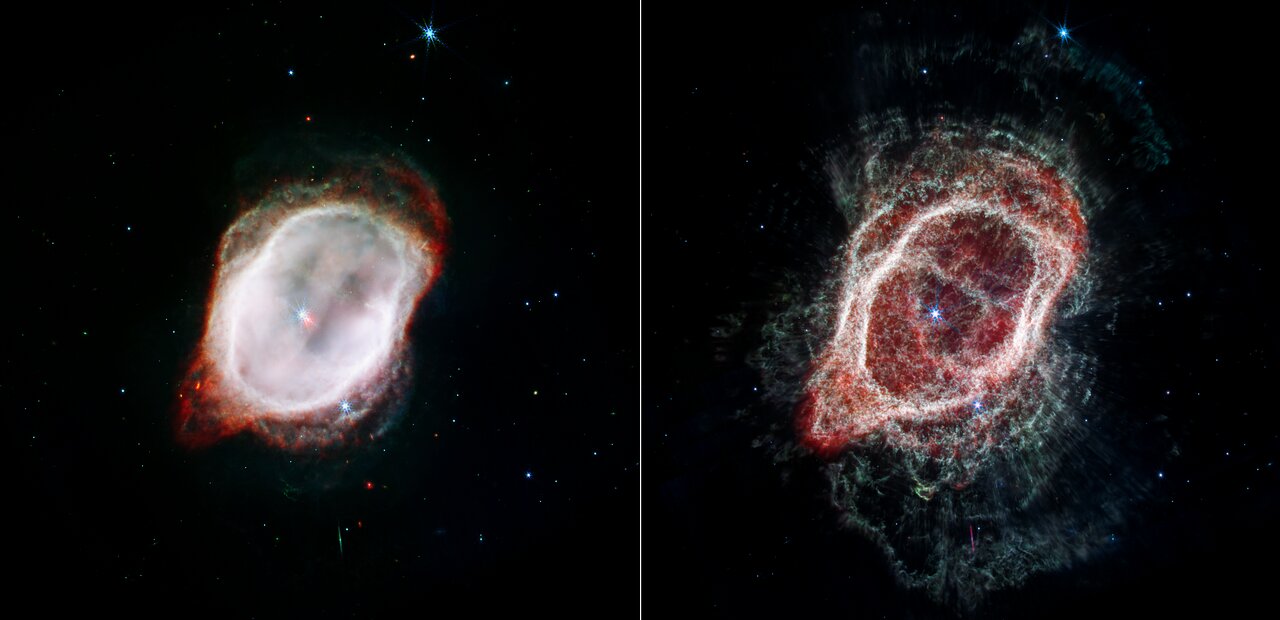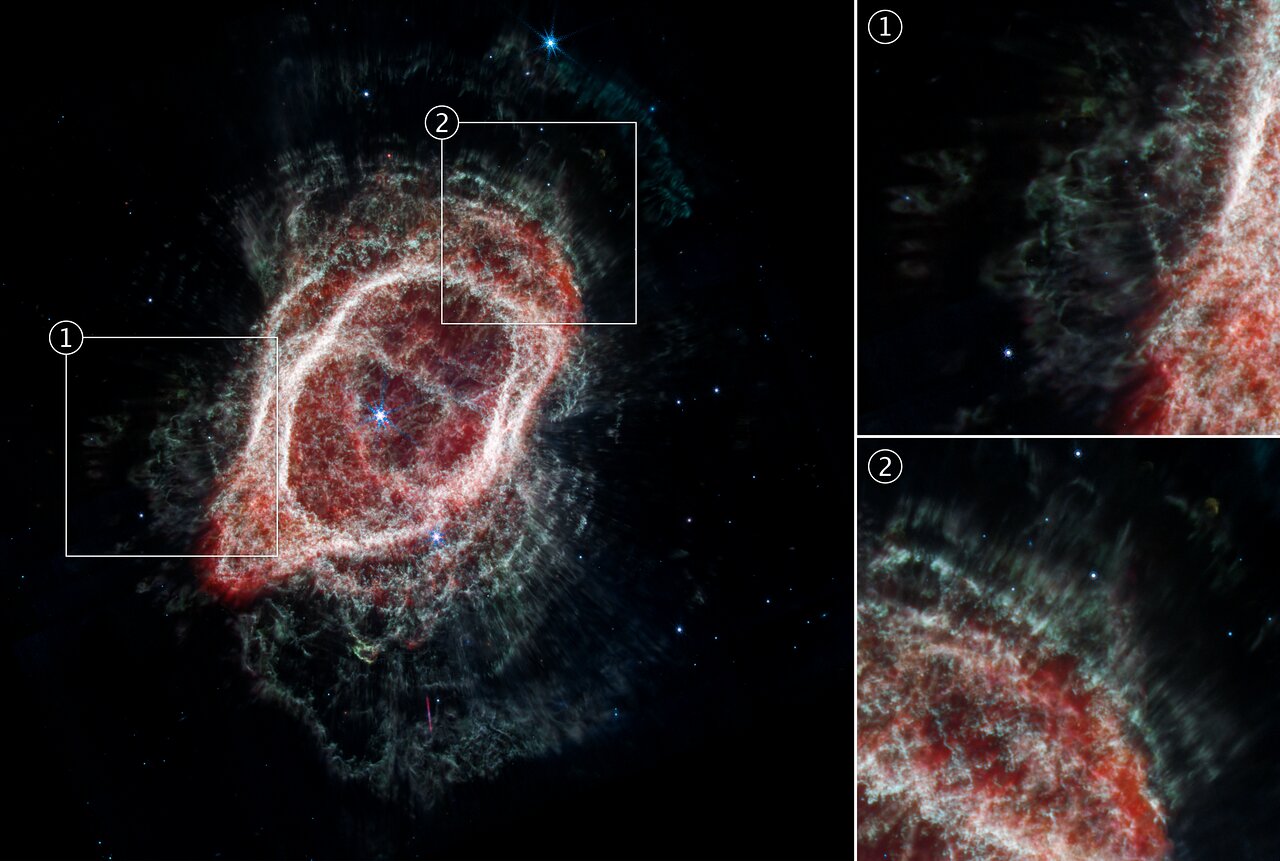James Webb Space Telescope Discovery
Clicking on each image will open the full resolution one. Try it!Clicking on "Raw images" image will yield all the relevant raw images.
Two Views of the Gas in the Southern Ring Nebula
The NASA/ESA/CSA James Webb Space Telescope offers dramatically different views of the same scene! Each image combines near- and mid-infrared light from three filters from the Near-Infrared Camera (NIRCam) and Mid-Infrared Instrument (MIRI).
At left, Webb’s image of the Southern Ring Nebula (NGC 3132) highlights the very hot gas that surrounds the central stars. This hot gas is banded by a sharp ring of cooler gas, which appears in both images.
At right, Webb’s image traces the star’s scattered outflows that have reached farther into the cosmos. Most of the molecular gas that lies outside the band of cooler gas is also cold. It is also far clumpier, consisting of dense knots of molecular gas that form a halo around the central stars.
By accounting for the temperatures and gas contents in both areas, inside and outside the band, and by combining Webb’s data with precise measurements from other observatories, scientists were able to create far more accurate models to demonstrate when gas was ejected by the central star (which appears red in the image at left).
What about the third star that is visible at the lower-right edge of the band within the nebula? From Webb’s vantage point, it appears within the scene, but isn’t part of the nebula itself. It’s merely “photobombing” this party.
Credit: NASA, ESA, CSA, STScI, O. De Marco (Macquarie University), J. DePasquale (STScI)
 Two views of the Southern Ring Nebula are shown side by side, which appear as a misshapen oval that is slightly angled from the top left to the bottom right. The left image shows two stars that are almost overlapping at the center. A large almost solid white oval surrounds the central stars. The right image shows one star at the center. A large translucent pink-and-red irregular oval surrounds the central stars.
Two views of the Southern Ring Nebula are shown side by side, which appear as a misshapen oval that is slightly angled from the top left to the bottom right. The left image shows two stars that are almost overlapping at the center. A large almost solid white oval surrounds the central stars. The right image shows one star at the center. A large translucent pink-and-red irregular oval surrounds the central stars.
 Southern Ring Nebula’s Gas (NIRCam and MIRI Composite Compass Image)
Southern Ring Nebula’s Gas (NIRCam and MIRI Composite Compass Image)
 Southern Ring Nebula’s Spokes (NIRCam and MIRI Composite Image)
Southern Ring Nebula’s Spokes (NIRCam and MIRI Composite Image)
 Southern Ring Nebula’s Gas (NIRCam and MIRI Composite Compass Image - Annotated)
Southern Ring Nebula’s Gas (NIRCam and MIRI Composite Compass Image - Annotated)
 Southern Ring Nebula’s Spokes (NIRCam and MIRI Composite Compass Image - Annotated)
Southern Ring Nebula’s Spokes (NIRCam and MIRI Composite Compass Image - Annotated)
 This is an image of the Southern Ring Nebula (NGC 3132), captured by the NASA/ESA/CSA James Webb Space Telescope’s Near-Infrared Camera (NIRCam) and Mid-Infrared Instrument (MIRI). The image combines near- and mid-infrared light from three filters.
Examine the straight, brightly-lit lines that pierce through the rings of gas and dust around the edges of the Southern Ring Nebula in the Webb Space Telescope’s image. These “spokes” appear to emanate from one or both of the central stars, marking where light streams through holes in the nebula. The holes are evidence of where the dimmer star that created this scene shot out material, creating open pathways for light to flow through.
Some of the star’s ejections followed thin, straight lines (second box) through the gas and dust. Other ejections (first box) look bent, curvy, and thicker. Why? A team of researchers modeled how these complex structures might have formed. Studies of planetary nebulae have shown that even when dying stars eject their gas and dust at all angles simultaneously, the outflowing gas may not stay symmetrical for long. In the Southern Ring Nebula, the team projects that the straight lines may have been shot out hundreds of years earlier and at greater speeds than those that appear thicker and curvy. It’s possible the second set is a mix of material that slowed, creating less linear shapes.
By carefully comparing the appearance and timing of these ejections in the data and simulations, the science team proposes that this is more evidence of the presence of a star with a slightly wider orbit that “stirred the pot” of ejections.
The dimmer star that created the planetary nebula appears as a faint red star next to the central blue star.
This is an image of the Southern Ring Nebula (NGC 3132), captured by the NASA/ESA/CSA James Webb Space Telescope’s Near-Infrared Camera (NIRCam) and Mid-Infrared Instrument (MIRI). The image combines near- and mid-infrared light from three filters.
Examine the straight, brightly-lit lines that pierce through the rings of gas and dust around the edges of the Southern Ring Nebula in the Webb Space Telescope’s image. These “spokes” appear to emanate from one or both of the central stars, marking where light streams through holes in the nebula. The holes are evidence of where the dimmer star that created this scene shot out material, creating open pathways for light to flow through.
Some of the star’s ejections followed thin, straight lines (second box) through the gas and dust. Other ejections (first box) look bent, curvy, and thicker. Why? A team of researchers modeled how these complex structures might have formed. Studies of planetary nebulae have shown that even when dying stars eject their gas and dust at all angles simultaneously, the outflowing gas may not stay symmetrical for long. In the Southern Ring Nebula, the team projects that the straight lines may have been shot out hundreds of years earlier and at greater speeds than those that appear thicker and curvy. It’s possible the second set is a mix of material that slowed, creating less linear shapes.
By carefully comparing the appearance and timing of these ejections in the data and simulations, the science team proposes that this is more evidence of the presence of a star with a slightly wider orbit that “stirred the pot” of ejections.
The dimmer star that created the planetary nebula appears as a faint red star next to the central blue star.
 Illustration of Star Interactions in the Southern Ring Nebula
Illustration of Star Interactions in the Southern Ring Nebula
 Raw images
Raw images